#everykid
Explore tagged Tumblr posts
Text
TIGRAAS Incorrect quotes#69 Boooring
Imagine the Freedom Academy children just dubbing you & Rimuru as their "Mom & Dad" around the Tempest Federation...
After giving a tour the kids huddle around Rimuru
Alice*Tugging Rimuru coat,shivering*DAD IM COLD!
Ryota*Sneezes and nods*DAAD IM FREEZING!
Rimuru*Double-take at being called a dad, looking between the two only for-*!?!
Kenya*Whines with pout*DAD IM HUNGRY!!!
Chloe & Gabe*Rubbing their bellies with tummy gurgles*DAAAD WE'RE STARVIIING!~
Rimuru*Looking at everykid,mind going into over-drive*!?!?!
Alice: DAD!
Ryota: DAD!
Chloe: DAD!
Gale: DAD!
Kenya: DAD!
All of them*Huddle to him*DAAAAAD!?
Rimuru: OKAY!?-Can everyone stop saying, Dad!-
Chloe*Pouts and crosses her arms*I think Dad is actually BORING! "Mom" is way more fun
Rimuru*Pained gasp*...
Y/n*Heard what the kids said, carrying the kid's sweaters, and a picnic basket*Oooh~Thats nice to hear!~

#that time i got reincarnated as a slime#that time i got reincarnated as a slime x reader#tensei shitara slime datta ken#tensei shitara slime datta ken x reader#ttigraas#tssdk#rimuru tempest#rimuru tempest x reader#rimuru tempest x y/n#rimuru x reader#rimuru x y/n#alice rondo#chloe aubert#gale gibson#ryota sekiguchi#kenya misaki#ttigraas incorrect quotes#tssdk incorrect quotes#incorrect quotes
341 notes
·
View notes
Text
It's kinda funny how the Everykid Protagonist in MG has changed over the past 20 years.
42 notes
·
View notes
Note
YES! Digimon Adventure 02, my favorite *starts rubbing hand together* i'm going to be so obnoxious.
Anyway since you're done with Adventure could you rank the Chosen Children up to now? I'm really interested in hearing your thoughts.
Let's see. Chosen Children from Most Favorite to Least Favorite, since I don't actually have any I dislike.
1 - Tachikawa Mimi. I'm sure there are no surprises about that one. Mimi's job is to be the relatable everykid. The one who acts the most like what an actual real-life ten-year-old thrown into this situation would act like. She cries, she screams, she wants to go home.
But she still pulls it together and has a lot to contribute all the same.
All of the kids do a great job of being relatable, honestly. But Mimi has the most interesting journey to me,
2 - Kido "Joe" Jou. You know, as a kid, I adored Yamato so much. He would have been my #2. But as an adult, I can't help but appreciate how hard Jou-senpai worked at the mostly thankless job of trying to be responsible for these kids.
He's just as scared and confused and lost as they are, and in the beginning the burden of responsibility weighs so heavily on him that it nearly breaks him. But he rises to the challenge. Even after they decide Taichi is officially team leader, Jou is always looking out for them, always trying to guide them as their senpai nonetheless.
Jou giving his life to save Takeru is my favorite Crest activation of the lot.
3 - Ishida "Matt" Yamato. He's still up there, just not as high as Jou. Yamato is the most damaged of the Chosen Children at the start, though it may not be immediately obvious. He comes into the series with more baggage than anyone. He's already carrying his parents' divorce on his back and emotionally spiraling down a defensive rabbit-hole before we even know his name.
Yamato isn't capable of being a selfish person, and that much is on display left and right. His kneejerk reactions are almost always for the betterment of the group. He can't help himself but to care about everyone else. But he's so messed up that he thinks that's a character flaw. Who he is and who he wants to be are miles apart, and who he wants to be kinda sucks so that's a good thing.
4 - Takenouchi Sora. Sora's carrying some damage on her heart as well. She's similar to Yamato, in that there's a stark disconnect in her character. Not who she is vs. who she wants to be, but rather who she is vs. who she thinks she has to be.
I love how much attention her dynamic with her mom gets in the Vamdemon arc. Sora has the most interesting and dramatic home situation out of any of the kids.
But it does feel like the show starts to de-emphasize her over time, particularly in the Dark Masters arc where Sora routinely has to be protected or saved and rarely gets to be the one who looks cool. Whether she's propping up Takeru, Hikari, or Yamato, Sora often ends up taking a backseat as the series draws closer to its conclusion.
5 - Takaishi "T.K." Takeru. I didn't actually like T.K. as a kid. He just seemed like an annoying little kid. But that's because of the dub downplaying his growth and his strength. Ironically, Takeru is probably the one of the original seven who already has his shit together the most from the start.
He's innocent, naive, and abhors violence, but he's not a helpless baby either. Takeru is resourceful, strong-willed, and contributes as much as anyone to the children's survival. Which is, itself, a key factor in Yamato's arc as much as his own.
6 - Yagami "Kari" Hikari. Hikari suffers tremendously from entering the series so late. She has very limited opportunities to shine, something that 02 will help her with.
She makes good use of what she gets and has a lot of great moments nonetheless. Granted, she's a little bit deus ex machina-ey, but she's literally the Light of the Eight Gods so we can forgive her for that.
7 - Izumi "Izzy" Koushiro. He made my kid cry.
No, I jest. Koushiro's in a rough spot where, as the computer nerd of the group in the Digital World, he has to try and walk a tightrope between "Koushiro OP plz nerf" and "It feels like Koushiro should be doing more."
It's not a tightrope he walks easily. He gets off to an interesting start as he's building out his understanding of the Digital World. But that kinda reaches a head at Etemon's pyramid and after that he just starts leaning on stuff Gennai gives him.
Once the setting is well-established, we don't get to see him do cool things like writing a program that will display a holographic map of Etemon's pyramid in physical space anymore. Gennai gives him all of his tools going forward and he just... sorta becomes the Pokedex.
8 - Yagami Taichi. He yelled at my kid for grieving dead friends.
That's less of a jest. More generally, Taichi has a lot of good points. He's the one who keeps his eye on the ball during the Dark Masters arc and keeps pushing forward while Mimi, Jou, and Yamato are having their respective crises. He's usually the guy you want to lean on in a crisis.
But wow, can Taichi be insufferable at times pre-development. He's reckless, self-centered, occasionally sexist, and utterly insensitive to the thoughts and feelings of others.
Taichi is a wild card. You never really know if you're gonna get "gets everyone caught by Etemon because he thought it'd be funny to cause trouble" Taichi or "pulls this team back together after they split up" Taichi.
Though meeting Homeostasis near the end and hearing the background of their adventure seems to do wonders for Taichi putting all of this to rest and becoming an emotionally stronger leader.
17 notes
·
View notes
Text
MY SON
MY CHILD
MY BABY
MY BOY
MY LITTLE DEVIL
MY SWEET SWEET BABE
EVERYONE

look at him
79 notes
·
View notes
Text


One of my favorite things about Tim’s Robin era is that you have DC writers/editorial periodically remembering that Tim Drake was first conceptualized as the relatable-to-readers, fanboy, everykid Robin. So you get these fantastic scenes where they’re leaning into the “He’s just a teen! A teenager! Being Robin!” Of it all.
Oh yeah, he’s just a normal high school kid stress dreaming about showing up to school in the wrong clothes and keeping secrets from his dad! Cheers! Anyway! Let’s get back to watching him fight Twoface.
(Robin (Volume 2) #11 1994)
#dc#comics#also Tim WHAT is happening with your leg muscles in that first panel there bud?#His quads have quads#They look like the interior of an orange slice#I love comics#Tim drake#robin
8 notes
·
View notes
Note
MY hot take about Vriska that no one asked for is that she's just disappointing. Like she gets So Much Time And Focus and she does So Many Things that are crucial to the plot and the progression of various characters, but it is so disproportionate in comparison to every other troll and even some of the human kids. Therefore the time spent on her had better be justified. You better make us enjoy our time while she's onscreen. Either we're interested in how fucked up she is, we yell raucously about how much we hate her, or we cradle her in our arms like a poor little meow meow, and Vriska Serket inspires None Of This in me.
She gets just enough development and we are given just enough opportunities to sympathize with her that we understand her and we get what her fucking deal is, but the shit she does and says is way too awful for me to ever like her, so it becomes this Net 0 Emotional Investment because I don't enjoy hating her either because she's not some glorious cackling center of villainy and hubris that I wish to see fall, that's Caliborn. I LOVED Caliborn everytime he was on page, he's a phenomenal villain I want to squeeze him until his stupid glass doll eyes pop. I want to write an AU where he and Callie are a silly little cherry limeade duo who somehow fucking Actually Made Things Work fully in spite of their fated animosity. He's AWFUL and I love watching Hussie smack talk him to his face through an arbitrarily frustrating computer modem radio tower thing.
Vriska is an intentionally bad protagonist because That's The Irony; she's a light player and she's shaped her entire personality around being the coolest and the best and the center of everything, but in doing so she's made herself an awful friend and a bad person who's Very Un-Protagonist-Like. But she's a bad *antagonist* because she's never actually framed as An Antagonist, she is simply antagonistic by a cruel stroke of bad luck that her life was set out to be lived on Alternia where she must blah blah blah EVERYONE is on alternia bitch, Get Over Yourself you are SO pretentious and not even in a fun way!!! In an annoyingly realistic way!!!!!
She's written as a real person in contrast to all these cartoonish personalities literally everyone else on the cast has. Everyone but Vriska in Homestuck is SO much more entertaining than her because she's written to be a normal girl in a fucked up situation while John is written to be a riff on The 90's Everykid who's encountering some truly absurd bullshit for the first time in his life. It's no secret Vriska's Hussie's favorite, and because of that, she gets so much focus and fleshing out and narrative weight that she Does Not Need.
Vriska would be better if there was less of her just Point Blank, because then we'd have a lot of potent moments where we see how monumentally messed up this kid who's constantly trying to keep all the randomness and peril in her life under her control is. Vriska being this awful person who everyone agrees is awful but who they keep around 'cause she's not awful ALL of the time and some of the group has unfortunately formed a deep attachment to her meanwhile she's constantly doing her 'All according to keikakku' shit would be WAY less disappointing as a central character. Also give other people who Aren't Her some of her consequential shit, the distribution is WAY too disproportionate.
(did not expect this to go on as long as it has whoops)
.
23 notes
·
View notes
Text
Round 2 poll 10: Ella from Ella Enchanted vs Ramona Quimby


propaganda under the cut:
Ella:
Ella is cursed to be obedient, forcing her to follow any command given to her. Despite this, she strives to find ways around the curse or cause problems for those who make commands. She’s also a budding linguistic, learning multiple languages on her journey. Furthermore, Ella's curse serves as a metaphor for the lack of autonomy children experience in society, often being made to do things beyond their control because adults in their lives dictate it so. Clearly, a strong contender in the race!
Cursed with obedience, Ella will stretch her limits and find any loophole to disobey orders, and in the end it is her indomitable spirit and deep love that enables her to break her own curse. She is also clever, funny, incredibly gifted with languages, and has a heart for justice.
Ramona Quimby:
Ramona is a perfect example of how specificity makes a character feel all the more universal. She's such an everykid and she's utterly unique. She named her doll Chevrolet just because it sounded pretty. She fainted at school when she refused to take off her extra cozy pajamas so just put her clothes right on top, because that's what firefighters do so how can it be wrong. She hatched an elaborate plan to get her dad to quit smoking-- she cares about him very much and did her best to help him through a rough time of his own. She squeezed out an entire brand new tube of toothpaste because who wouldn't want to at least try that. She invented a game called Brick Factory which is basically just banging bricks togethed until they break. She has an extreme, uncontrollable compulsion to pull a classmate's curls and say "BOING!" Honestly I don't know when to stop here.
one time she cracked a raw egg on her head because of a boiled egg fad. unless that was a different book. she likes cars and she is awesome.
She's just a normal kid, but her books were great at dealing with social issues from a growing girl's point of view for kids of the time. They're definitely dated and quaint by now but she's still a charming character and a local icon here in Portland, OR, where the books were set.
Ramona is peak little girl energy. She's weird and full of chaos, big emotion and wanting to do things now instead of waiting for things to happen. Ramona is also one of the best examples of being a little sibling, being annoying and impulsive and causing problems but mostly not on purpose. I used to be obsessed with these books when I was little.
27 notes
·
View notes
Text
PANEL DISCUSSION
From time to time Your Humble Narrator likes to sort through the stacks of old comic books of which he has far too many. A recent such rummage led me to reflect, on the last day of Black History Month, that I learned a fair amount of what little I know about black history not at school but from comics.
Although Adalifu Nama's Super Black: American Pop Culture and Black Superheroes (2011) is a lively and accessible study, its focus is deliberately narrow. As far as I can find, a comprehensive history of the black presence in comic books, both as characters and as artists, writers and publishers, is yet to be written. Reading up to review Marvel's Black Panther a few years ago, I came across a reprint of All-Negro Comics from 1947...

...which contained probably the earliest black superhero, Lion Man; even though the title was run out of business after only one issue, it left me wondering if it could have influenced the creation of T'Challa years later over at Marvel.
But in my collection, amongst the superhero, scary and funny titles, I found a number of civic-minded, non-fiction comics devoted to black history, most notably...
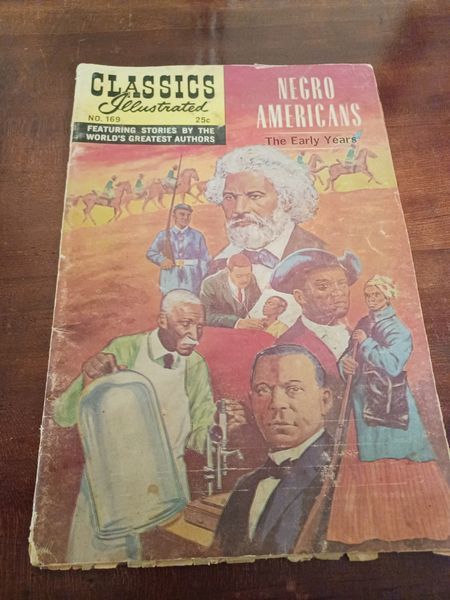
...the 169th issue of Classics Illustrated, Negro Americans: The Early Years, from 1969. Classics Illustrated were highly abridged and expurgated adaptations of literary classics intended to interest kids in reading, and I was their success story: the dorky kid who actually became a bookworm at least partly because of the hours I spent poring over these mostly lame version of Wells and Verne and Hugo and Melville, and even Homer and Shakespeare.
Negro Americans was different than the other Classics Illustrated titles, however, in that it wasn't based on a classic book; no author is credited. On the table of contents page it says "...we try to give accurate accounts of some of those black men and women who gave their talents and lives to their country during its formative years. Space allows us to show only a few of these black heroes...The efforts and triumphs of these black men and women live as their legacy to American heritage."
I bought this comic off the stands sometime in the early '70s, and learned from it--not from school--that Crispus Attucks was arguably the first man to die in the American revolution when he fell in the Boston Massacre...
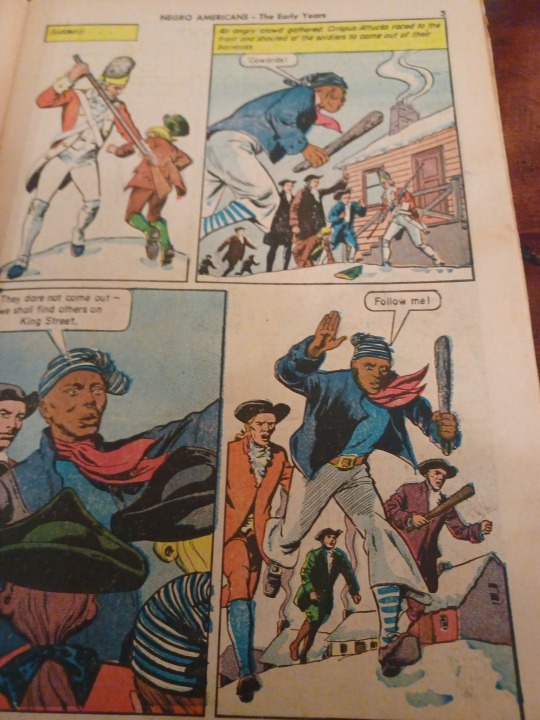
...or about the advances in heart surgery by Daniel Hale Williams...
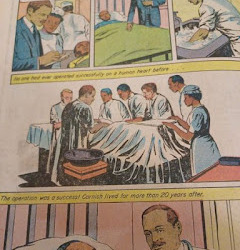
...among many other extraordinary accounts.
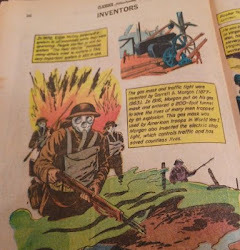
I also have the Classics Illustrated version of Uncle Tom's Cabin, from 1944...

...with better-than-average art for the series.

A while back I acquired (for a dollar an issue!) a full run of the Golden Legacy comics, a series of 16 books on black history published from 1966 to 1976. Most of them concern African-American history--Crispus Attucks, Harriet Tubman, Benjamin Banneker, Martin Luther King, Jr., arctic explorer Matthew Henson, Amistad mutineer Joseph Cinqué, and two volumes on Frederick Douglass, among others. But there are also issues on ancient African civilizations, on Toussaint L'Ouverture and the founding of Haiti, and on the ancestry of Dumas and Pushkin. Again, they didn't teach most of this stuff at my school.
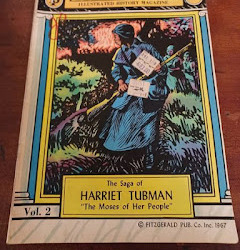
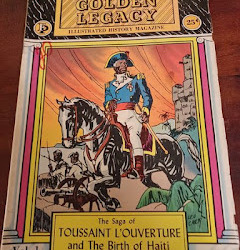




The art was pretty cool, too.
My stacks yielded a couple of '70s-era comics featuring Quincy, the everykid from Ted Shearer's newspaper strip...
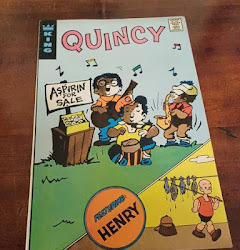
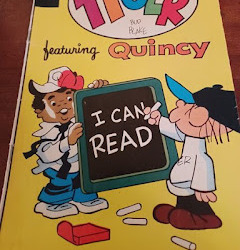
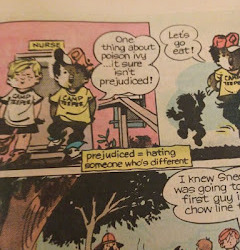
They were published by King Comics, the periodical arm of King Features Syndicate. Along with Quincy's adventures with his white pal Nickels and others, the books featured educational content, teaching readers proper grammar, etc...

Moving away from educational comics, I found several issues of Midnight Tales, a creepy Charlton Comic that ran from 1972 to 1976. It's noteworthy not because of any specifically black content, but because the artist, the marvelous Wayne Howard (1949-2007) was probably the first African-American comic book artist to get a "Created by" credit on his title. Indeed, he was one of the first artists of any race to do so; comic books were usually uncredited in earlier decades.
In Midnight Tales Howard, in collaboration with writer Nicola Cuti, dreamed up Dr. Cyrus Coffin, aka "The Midnight Philosopher," who collected strange yarns with his beautiful raven-haired neice Arachne. I still think it would make a wonderful TV series on, say, the CW Network.
I love the macabre wit in Howard's artwork...


Or my favorite of his covers, from the first issue...

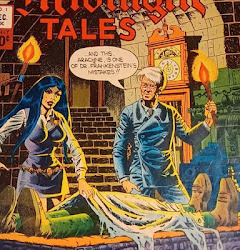
How much had Dr. Frankenstein been drinking when he made that mistake?
Finally, I came across a striking 1984 issue of All-Star Squadron, DC's superhero team-up title set in the 1940s. This particular story...
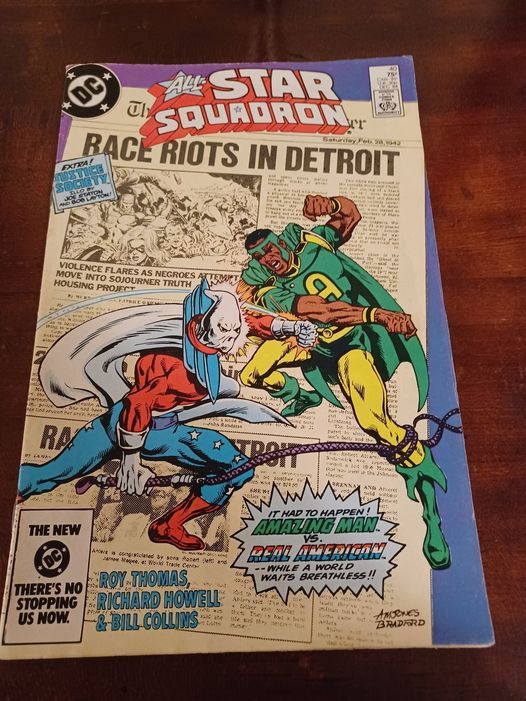
...is set against the real-life backdrop of the white rioting against the residents of the Sojourner Truth housing project in Detroit in 1942. More strikingly, it features black superhero Will Everett, aka Amazing Man, facing off against a hooded supervillain wonderfully called "Real American," who has the hypnotic power not only to turn the white citizens into mindless, violent racist rioters, but to have the same effect on some of Amazing Man's superhero allies.

Hard to imagine that some Republicans in congress wouldn't love to get their hands on that technology...
5 notes
·
View notes
Text
OOC: heres what everykids house (so far) is supposed to be
Elle: a smaller, one floor version of the after au apartment building
Navy and Honey: a small cottage-like house. very cozy, full of plants
Barley and Capri: the default house, two floors, door to the roof, added front porch
Soup and Cam: default house, two floors, no roof door or porch, less windows
Holly and Nate: made to look like a motel room, dome added after the house itself was made.
Gin: treehouse
6 notes
·
View notes
Note
i love the idea of them being the fun-gruncles that everykid wants to have-🕸
Roman and Patton are definitely going to have kids when they find the right partners and someone has to lovingly corrupt those little ones. They're all going to be living together anyways and it takes a village, right?
0 notes
Note
Comment by geodude96: Perhaps some of her equipment could be explained as her having taken/borrowed/stolen it from her father?
That’s possible! I think that would make sense with her original motivation of wanting to thwart/spite her dad (foiling him with his own equipment is a big Fuck You), while also not countering the other info we have about her resources.
I don’t remember which issue she gets into a fight in one of the commerce areas out in the suburbs, I just remembered a busted up sidewalk grocery stand, and an angle that showed, much like her neighborhood, the buildings are not tall, that there isn’t that imposing Gotham skyline.
I do have the context for this panel:

[image description: comic panel of Spoiler with speech bubbles saying “Maybe Gotham needs a Spoiler. You and Batman handle all the crime in the city. the suburbs don’t have anybody. We bounced those gunrunners good. But this kid at Gotham Heights High still gets killed.”]
That’s from issue 25 of Robin 1993, in which Stephanie & Tim are both investigating the death via gun violence of one of Tim’s classmates.
~
I’ve said elsewhere that it matters for Stephanie’s early role as Tim’s foil that they’re relatively close to each other’s socio-economic classes in comparison to other characters (https://mzminola.tumblr.com/post/706089783579049984/dc-bat-comics-have-a-lot-of-classism-issues-among) but I also wanna add that I find it to be...
Well, an example of DC not being hideously classist?
Some of Spoiler-versus-criminals is, the exact same way Batman, Huntress, Oracle, etcetera versus criminals usually is.
But Stephanie having an addict mom, a criminal dad, a teen pregnancy, a house damaged by an earthquake, childhood sexual trauma, all while being a financially secure middle class teen from the suburbs is DC acknowledging the reality that those issues can affect anyone, regardless of socio-economic class.
The resources people have for dealing those issues is greatly effected by socio-economic factors, as well as how they’re viewed by others. But not the fact that they happen at all.
Batman comics often deal with extreme ends of criminal economic brackets. Street crime by people trying to survive, the wealthy using their money for evil, mafias being a combination of wealthy leadership and desperate ranks. The way that’s all handled is one of the places DC’s classism most shows.
Stephanie’s family is an exception to those extremes. (There are others, but they’re often one or two issue characters, while Stephanie is a recurring one.)
Arthur Brown doesn’t need to do crime to survive, and he also isn’t wealthy enough to wield money as a weapon. He’s just a guy who decided to do costumed crime.
Stephanie’s house is damaged because it’s in an earthquake, but not completely destroyed because it’s far enough from the epicenter, and that’s a sheer lucky coincidence.
Stephanie’s dad is abusive, and he’s middle class (Jack Drake is abusive, and he’s whatever the hell the Drakes are).
Stephanie is exposed to a sexual predator as a child because the guy is an associate of her dad’s who came to the house, something that happens to people in all economic brackets. It happens with parents’ coworkers, bowling league buddies, family, etc.
Crystal has a drug addiction when first introduced, and it damages her relationship with her daughter. Crystal is a middle class suburbanite.
Stephanie has a teen pregnancy arc because she had sex with her boyfriend, something a lot of teens do.
While Bats all crossover between each other’s comics, Stephanie / Spoiler got her start and spent the majority of her Preboot era run as a supporting character in Robin 1993, which was meant to have an ‘everykid’ protagonist and deal with Teen Issues alongside the superhero adventures.
And the supporting cast was part of that.
Steph’s problems, Ariana’s brush with sexual assault on a date and feeling like she can’t tell her guardians, Ives’ health issues, Tim’s family problems, all of that was meant to be relatable to the reader.
(This is one reason Steph also works really well as supporting cast in Batgirl 2000, which I think was meant for a similar audience.)
And yeah, it's frustrating that DC sees ‘middle class’ as the default, but in this case they took a handful of issues stereotyped as being ‘just poor people problems’, that people pretend don’t happen to anyone else, and by giving them to Stephanie, basically said, “These are universal problems, and our readers could be dealing with them.”
If you ever have the time/interest, would you break down the canon surrounding Stephanie’s economic circumstances/home life? It seems like a lot of people have chosen to take it a specific way so I’d love to see your reasoning
Sure. Thanks for asking, it's honestly a fun topic.
Y’know it’s funny—I actually happen to own something that I think most people, even most Steph fans, haven’t seen: Steph’s first appearance. Not her Robin first appearance, her Detective Comics first appearance, her actual introduction. I happened to pick them up by accident at a con a few years ago because they’re also some of Tim’s first cover appearances.
Other people might disagree with me on this, but I like to go back to the characters’ origins whenever I can to find the baseline of what they were originally intended to be and try to bring later interpretations in line with that. I like to think of retcons as new revelations, new plot twists in an ongoing story, and not a way to reset aspects of the past just to fit your story. It works especially well for this because Steph’s socio-economic status doesn’t actually change, there’s just kind of a game of telephone that happens across the decades that leads people to misunderstand.
One thing worth noting in these early issues is just how much Steph, a 16-year-old girl, has at her disposal before she ever even glimpses Batman and Robin. Literally the first shot we ever see of the Spoiler is this:
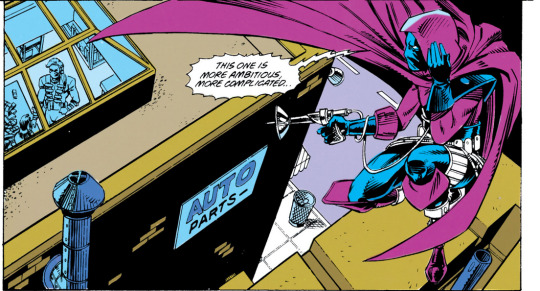
And because I am, in fact, that kind of nerd, I have gone in a couple of times and dug out old era-appropriate electronics magazines to figure out what that piece of equipment would cost you in 1992. Baseline for a parabolic microphone is $600, and that price is for much larger, more delicate pieces of equipment meant to be used for like, outdoor nature shoots, which wouldn’t be able to hear through glass. Steph probably dropped $1,000 on that microphone alone.
Remember also that her costume is homemade—she doesn’t have any other way of getting it. She’s also shown using some pretty elaborate climbing and painting gear, with no indication that they were stolen or borrowed or anything, and you can see that she’s got a pretty well-stocked utility belt there.
Again, for some reason people tend to forget or overlook this but, right up until she demanded Bruce make her Robin, Steph operated as Spoiler with zero Bat support. She got some hand-to-hand training from Cass late in the game and tagged along on some of Tim’s assignments, but was otherwise being actively discouraged from vigilantism for most of her career. She made her own costume, bought her own equipment, and maintained her own motorcycle, all without the financial support of either Batman or her parents.
So right off the bat we know she’s a teenage girl with a not-insignificant amount of personal disposable income, the only hinted source of which is the implication she works a part-time job somewhere—which I don’t think is ever brought up again when she reappears in Robin.

We all know minimum wage went further in 1992 than it does now, but it didn’t go that much further. So it’s reasonable to assume that Steph has access to at least some money from her parents to support her vigilante habit, whether that’s in the form of an allowance, gifts that she carefully manages between Christmas and birthdays, or money that she’s able to just, take from Crystal without her noticing.
But this page is more important to our current interests because it’s also when we see Steph’s neighborhood for the first time. We’re told here that Steph and her mother (who is called Mrs. Agnes Bellinger in this comic, although it’s possible she was using a fake name to visit her ex in prison) live in what is described as “115 South Holden Street, in Manchester.”
Now keep in mind, the Gotham City map can be extremely fluid and tends to change depending on the needs of the story. But there have been attempts to map it, and “Manchester” has never been on any of those maps, so we have to do some extrapolation. At the very least, we can tell the neighborhood is clearly not in the city, given the very deliberate angle there in the first panel to show that they’re well away from the crowded downtown Gotham skyline.
This implies that Manchester is intended to be one of the mainland suburbs that feeds the island city of Gotham, similar to Bristol Township where the Wayne and Drake Manors are located. It’s not nearly as nice a neighborhood as Bristol—note the fenced-in front lawns, the broken shutters on the neighboring houses, and the vaguely racist lawn ornament on the Brown’s property—but it’s also not some rundown slum. People aren’t afraid to let kids play in their front yards or leave their garage doors standing open. And you'll note those aren't trailers, either, they're decently-sized suburban homes.
Also worth noting: Crystal seems to keep this house perfectly fine on her own as a single mother. Arthur doesn’t live with them; when he’s shown having residences it tends to be apartments in the city by himself, and it’s not like he could support them from prison or with his ill-gotten criminal gains. And yet, we don’t see Steph or Crystal worrying at all about bills or mortgages or anything like that throughout any of their appearances. We see the interior of their house on several occasions and, while it’s often messy, it’s not in disrepair or neglect.
This is a constant portrayal throughout all of Steph's appearances, from Robin through even her run as Batgirl. So, with that in mind, where does the idea that Steph is poor come from? Well, I’ve got a couple of theories.
One is the usual comics fandom problem: canon is huge, nobody can keep up with all of it, and some people go out of their way to be assholes about it, so misinformation gets spread like wildfire, in no small part because Steph is a character that a lot of people use as a self-insert and therefore she must be the misunderstood underdog in all things.
But on the more-interesting-to-talk-about front… I don’t think it’s controversial to say that Steph’s first big storyline was her pregnancy. Yeah? Like, it’s the first story involving her that really started getting critical attention. Whether it deserves that attention is more open to debate—personally, since reading Icon & Rocket for the first time, I’ve come to view it as Dixon pulling the comic book equivalent of white guys repackaging black music and watering it down—but the important thing right now is that it’s the first time people would’ve been specifically reading the Robin comics for Stephanie Brown. And in those comics, Steph’s house is shown as visibly run-down, covered in cracks and disrepair.
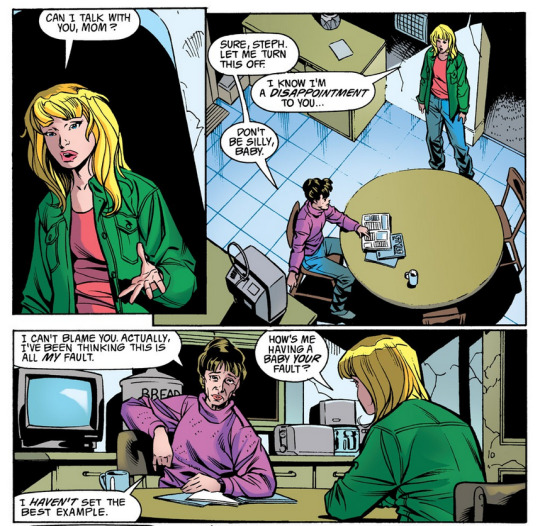
Thing is, there’s a context that people miss if you’re reading for the baby storyline and nothing else: this storyline plays out over the last days of “Aftershock” and early months of “No Man’s Land,” the storyline where Gotham is racked by a destructive earthquake that nearly levels the city and is abandoned by the federal government.
Again, we get the reinforced confirmation that Steph’s house isn’t actually in Gotham because it’s not destroyed in the quake—the neighborhood is damaged and briefly evacuated due to a gas line rupture in the immediate aftermath, but once that’s cleared up they’re free to return home, and their suburb is not part of the federal government's evacuation. Nearly every building in Gotham is shown with similar damage during this time, including Drake Manor.
This storyline also plays into, I think, the stereotypes that people jump on when it comes to Steph’s socioeconomic status. Like I’ve mentioned before: Arthur is a criminal, Crystal is a drug addict, and Steph is a teen mom. Therefore, they must be poor, right? Because good middle class families supposedly don’t have those kinds of problems.
But, as I’ve mentioned before, that’s an inaccurate stereotype that ignores reality: plenty of drug addicts, criminals and teen moms live in the suburbs. And the Browns’ specific circumstances are distinctly atypical of the stereotype—Arthur’s not some down-on-his-luck thief pushed to crime by economic hardship, he’s an arrogant former gameshow host who thinks he’s smarter than everyone else and resents the world for not handing him the success he feels entitled to. Crystal’s not some crack addict, she’s a working nurse who used to get her doctor friends to write her scripts for prescription painkillers. And Steph is just a teenage girl who slept with a boy and got pregnant, with the costs of prenatal care and/or childrearing never seeming to be a factor in her decision to bring the child to term and give it up for adoption.
I could go on but that’s pretty much the long and short of it: Steph is simply not shown as being poor in the comics. Ever. She’s not rich, she does clearly rely on her fists much more than any gadgets or fancy gear and lives with her mother rather than moving out on her own for college, but she’s also never shown worrying about student loans and can apparently pay for all her classes with some government assistance and a part-time job alone.
People just assume that she’s poor because they’re misinformed, or they’re projecting, or they’ve got biases they haven’t examined, or they need her to be an underdog to justify their argument against one of the other characters, or they really want her to be buddy-buds with Jason for some reason.
Or, y’know, they just don’t want to acknowledge that they’re rooting for a middle-class white girl from the suburbs who commutes into the inner city to pick fights for fun.
#I am still waking up so I dunno how coherent this is#classism#DC#Batfam#Spoiler#Stephanie Brown#putting this addition as a direct reblog from OP instead of getting bogged down in the other threads#listen if Steph actually had a lower class background you KNOW Bruce would've been#shit talking her the way he shit talks Jason#and he really...doesn't#he's a sexist ass the way he is with nearly all gal characters#but he doesn't pull the 'bad seed' and 'just more scum in the gutter' crap with her#that he does with Jason#and Alfred doesn't either#UtRH Alfred I have so many bones to pick with you#comics meta
323 notes
·
View notes
Text
It's kinda funny how the Everykid Protagonist in MG has changed over the past 20 years.
0 notes
Photo

#everykid #deserves a day @canes_cafe !!! (at Canes Cafe & Corner Store) https://www.instagram.com/p/CCvxfgIps5M/?igshid=1piqii39spmzb
0 notes
Text
jfc was reading an old email correspondence from like 2012/13 and
o h boy
the cringe
anyway to the three people i talked to via text the most who are still floating around here- yami, james, and terra i am SO SORRY rip my writing
#hate that word cringe but there is nothing else to describe it as for once#melody babbles#i mena look you all know im pretty lackadaisical about all that#*mean.#but rereading some of that is pAINFULL.#even so. its fun seeing how close and far we all were to how we are now#idk just was neat i guess#i was a cringey kid but so is everykid and you gotta embrace it <3#anyway the amount of times i used SPAZZED XD is causing me psychic damage
2 notes
·
View notes
Text
What are “specifically neurodivergent traits?” That’s what I’m saying! That’s what I mean! What are those? Maybe she is—I don’t know, maybe she is, but it would depend on what those are. Nobody’s willing to venture forth any specifics.
I mean, to my knowledge, Vanellope is one of the least “unique” characterizations, in any sense, that I’ve ever seen. She has a “superpower-type” trait. But nothing about her personality is in any way unique. She behaves exactly like a 9-13 year-old kid with no parents and no friends would, in her situation. Bratty, spunky, hyper, goofy, fun-loving, mischievous. It’s her circumstances that are a little unique—bullied, outcasted, lives apart from everybody else. But her personality and her responses to things? She’s an everykid. That’s the point of her. Like it’s the point of Miguel in Coco. It’s the point of Ariel, too. The idea is, they’re relatable to just about everyone. Not just people who are “neurodivergent”—except I already said, “neurodivergent” means everything to everyone at any time, so it means nothing—so in that sense, sure, they’re “neurodivergent” because “neurodivergent” just seems to mean “human.”
Mulan is not a metaphor for neurodivergence.
Because none of you can describe what “neurodivergence” is. You can’t make a metaphor for something that is undefinable.
If you think Mulan “looks at the world a little differently than everyone else,” then sure, it’s a story with that in it. But guess what? Grandma also looks at the world differently than everyone else. Oh! And Fa Zhou looks at the world differently than Mulan! And Fa Zhou’s wife looks at the world differently than Mushu! And Mushu looks at the world differently than Shan Yu! And Shan Yu looks at the world differently than The Emperor’s Advisor!
Heyyy maybe we’re all humans who have our own unique perspectives & responses to the world around us. Some of us have some pieces of unique perspectives/responses in common, like fabrics we like the feel of or topics we happen to be focused on in this season of life, and some of us, shocker, have different pieces/responses in common! Hey, we’re all alike and we’re all unlike—which means we’re mostly alike! Even in the way we think!
Maybe you don’t need a word that means “I’m different, but not in a specifically definable way, just in a way that makes me both like and unlike some people, somewhere, sometime, depending on how ‘seen’ I need to feel in a given moment, and who/what piece of media I’d like associated with me/that given people group.”
Unless you can define “neurodivergent” beyond what I just said. Then tell me how Mulan is a metaphor for that definition—of “neurodivergent” beyond what I just said.
62 notes
·
View notes
Text

Your fave is in a collectors guide
#this killed me omf#i saw it at work#inside its written like everykids collectors guide ever#kpop#they said svt may have 13 people but only ONE will be on the cover#mamamoo
4 notes
·
View notes